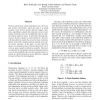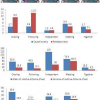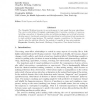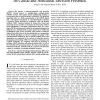1365 search results - page 1 / 273 » Maximal Causality Analysis |
ACSD
2005
IEEE
15 years 6 months ago
2005
IEEE
Perfectly synchronous systems immediately react to the inputs of their environment, which may lead to so-called causality cycles between actions and their trigger conditions. Algo...
140
click to vote
JMLR
2010
14 years 7 months ago
2010
In time series analysis, inference about causeeffect relationships among multiple times series is commonly based on the concept of Granger causality, which exploits temporal struc...
CVPR
2008
IEEE
16 years 2 months ago
2008
IEEE
In this paper, we address the pair-activity classification problem, which explores the relationship between two active objects based on their motion information. Our contributions...
104
click to vote
JMLR
2011
14 years 7 months ago
2011
The Causality Workbench project is an environment to test causal discovery algorithms. Via a web portal (http://clopinet.com/causality), it provides a number of resources, includi...
TSP
2008
15 years 24 days ago
2008
We present a reduced-complexity soft detection (RCSD) scheme geared to multiple-input multiple-output (MIMO) systems with spatial domain multiplexing leading to layered space-time ...




